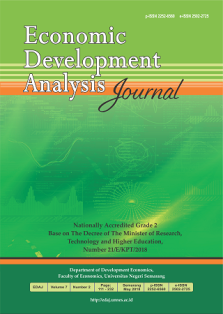Micro Small Industries Performance Improvement: Analysis of the KUR Program
Abstract
MSMEs contribute 61.07% to Indonesia's GDP, but over 40% face capital problems. Kredit Usaha Rakyat, or People’s Business Credit (KUR), is a government program to solve that by giving subsidies through financial institutions to strengthen MSME’s capital. Since 2015, the processing industry sector has been a priority sector of the KUR program, with KUR's realization target Micro Small Industries (MSI) is 40%, and the target continues to rise to 60% in 2019. This study analyzes the KUR program's impact on MSI performance in Indonesia. This study uses secondary cross-section data from the MSI survey of Badan Pusat Statistik or Central Bureau of Statistics (BPS) from 2014, 2015, and 2019 with Pooled Least Square (PLS) analysis method. The estimation results show that MSI who access the KUR program have a higher average income of 45% compared to MSI who do not access the KUR program. This means the KUR program significantly positively affects increasing MSI income in Indonesia. The results of the sub-sample analysis show that the income of the industrial sub-sectors, such as tobacco, paper, rubber, plastics, machinery, and equipment, are positively significantly affected by the KUR program, and the others, such as printing and recording media industry, base metals, computers, electrical equipment, electronic goods, motor vehicles, other transportation equipment, and repair services, installation of machinery and equipment are not significantly affected. Thus, the government should continue the KUR program, especially for the positively affected processing industry and sub-sector, to improve the performance of micro-small enterprises and industries in Indonesia.


